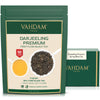While the world of teas seems heavenly and one needn't debate the gift of good health that comes with it, many of us still wonder about what's the difference between green teas and white teas. So what's the deal about Green Tea Vs White Tea? Let's read on!

Tea is one of the oldest and the most popular hot beverages that have been there for centuries and is still equally prevalent across global communities. The most common types of tea that are loved by tea lovers across the world include green tea, black tea, Oolong tea, and white tea.
People have made a conscious shift from coffee, with very high caffeine content, to more bounteous alternatives like green and white tea, considering the plethora of health benefits associated with them, including weight loss, reducing the risk of certain cancers, and a stronger immunity as well.
But as a lot of our customers have asked, we are here to discuss the difference between green tea and white tea?
Let’s first try to get to know about both green and white tea separately to figure out the difference between these popular tea types.
Green Teas

One of the widely consumed beverages in the world. Green Teas are made using the leaves of the tea plant - Camellia Sinensis and they offer a liquor that ranges between pale yellow to pale green in color. They have a rich vegetal taste and have wonderful herbaceous flavors with a milder caffeine content that black teas. As opposed to black teas, green teas are not oxidized and hence retain the natural green color. They straight go for a quick heat treatment in which the tea enzyme is destroyed, before being processed further.
Origin
Green tea is said to have originated from China and then make it way across to various parts of Asia. The Yunnan province in China is known to produce some of the best varieties of green tea and is also home to the mother tea plant - Camellia Sinensis. Fun fact, a majority of the types of green teas are actually from Yunnan!
One has to credit the Buddhists monks who traveled and helped popularize green teas to other Asian countries like India, Japan and many European countries as well. Talking especially of Japan, the Zen priests took the seeds of the tea plant from China. Green tea became central to the spiritual way of life, helping the monks meditate and focus for long periods of time. Today, China and Japan are known to be the two largest green tea producing countries in the world. The difference between Chinese and Japanese green tea variants is mostly the method in which they are harvested, grown, and processed.
Both green tea and white tea come from Camellia Sinensis, a tea plant, but the difference between green tea and white tea is the way they are processed. Both white tea and green tea differ in the age at which their tea leaves are picked and harvested. Both these teas differ vastly in their overall character which includes taste, aroma, texture etc. There is also the difference in the manner in which they are processed.
Read all about the 5 Best Green Teas You Must Try This Season and make them a part of your daily wellness routine.
White Teas

The much ambrosial white teas are one of the least processed teas in the world of teas. One of the rarest teas in the world, white teas are actually harvested from fresh, tender buds that appear when the tea leaves have not even opened fully. The young tender buds are covered with white hairs which are responsible for the characteristic white color of these teas and the name as well.
If you wish to read a detailed blog about the delectable world of White teas, then you can click here to read excerpts from our Tea master’s tea guides.
Origin
With tea holding centrestage in medieval China, presenting the emperor with the newest, most unique, and rare tea from young and tender buds harvested from the best tea bushes evolved into a common practice. White teas were said to be born out of this practice. The earliest white teas were harvested in spring and steamed. After removing the outer leaves, only the tender buds were used, delicately washing them and drying them. These dried buds were then ground into a fine powder, much like the popular Matcha tea these days. The powdered white teas were then mixed in hot water and an ethereal cup of tea was served.
White teas eventually traveled from China to other countries. Now a majority of them are produced in Taiwan, Northern Thailand, Eastern Nepal, India, and Southern Sri Lanka. However all these variants have quite different characteristic properties from each other.
Difference Between Green Teas & White Teas

Harvesting
Harvesting of White tea leaves is done at an earlier stage than green tea leaves, meaning that white teas are cultivated from tender buds of the tea bushes, even before the leaves have fully opened, whereas green tea leaves are selected after the buds turn into a shoot.
White tea is also considered to be quite rare, artisanal and exquisite because it only grows during the early spring days and makes for an expensive tea, unlike green teas.
Processing
One big difference between green tea and white tea is the way they are processed. It is the process of oxidation that makes the real difference. Oxidation is a process where the tea leaves are exposed to oxygen before further processing them. The more the exposure, the darker the leaves, and the deeper the flavor.
White tea is one of the least oxidized and processed teas. It is neither rolled nor fired, whereas green tea is usually steamed or pan-fried for a darker color and deeper flavor.
The oxidation process includes firing, roasting, steaming, rolling, shaping, and crushing the leaves. While white tea is plucked and allowed to dry in the sun, green tea is quickly harvested and heated by steaming or pan-frying. They are not dried too much to avoid the green color turning black. White teas, not being processed a lot, hence have a lot less caffeine compared to green teas and hence have a delicate, milder flavor profile.

Antioxidants
Besides the differences between white tea and green tea’s origin, harvesting and processing, both these tea have large amounts of polyphenols, a kind of antioxidant, that are highly beneficial for our health.
It has been found that White teas contain some of the same antioxidants as is present in green teas, but only in higher amounts and concentration.
Benefits of White and Green Teas
Both white and green teas are considered incredibly beneficial for our health as they are both abundant in various types of antioxidants. Some of the benefits of drinking green tea and white tea include :
-
Aids weight loss
-
Boosts metabolism, improves digestion
-
Boosts cardiac health, lowers bad cholesterol
-
Reducing the risk of certain cancers
-
Reducing signs of ageing
-
Strengthening overall immunity
Conclusion
We can’t precisely conclude which one among white tea and green tea is better because they are both equally bounteous and each has its own unique character. When consumed in limited amounts, tea, green or white, can truly make a marked difference in our overall health. After all, tea is one of the healthiest beverages on earth for good reason.
Relish some of the best Himalayan Green teas from Vahdam’s award-winning range with single-origin green teas and some quintessential green tea blends that bring together revered traditional spices and herbs.Be it our Himalayan Green Tea or the best-selling Chamomile Green Tea.
You can also choose from the brand’s celestial range of white teas that are truly rare and artisanal. Be it from the misty Himalayan foothills of Darjeeling or the heavenly Blue Mountain Nilgiri White Tea from the blue mountains in Southern India.
Until next time,
Cheers!

Mayuri Ghosh
Editor-in-Chief | Vahdam India
Write to me at mayuri@vahdamteas.com
UNLOCK AN OFFER FOR YOU!
Subscribe to our newsletter & stay updated! What's more - A SPECIAL DISCOUNT ONLY FOR YOU!












 INR ₹
INR ₹